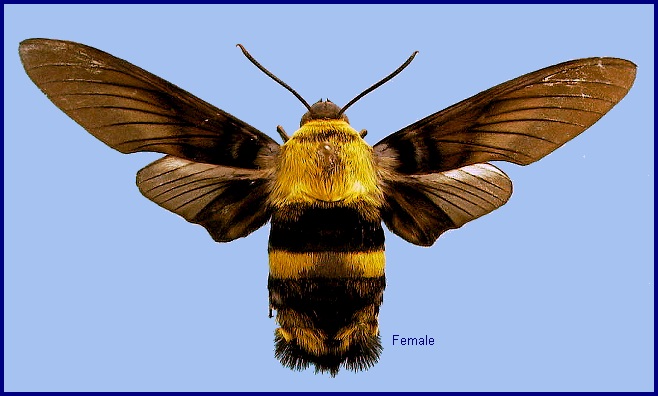
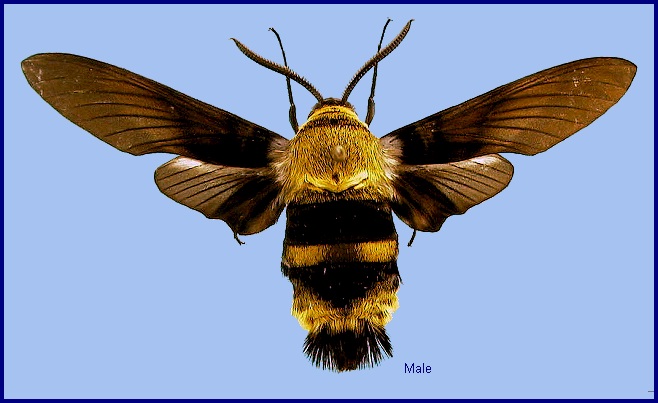
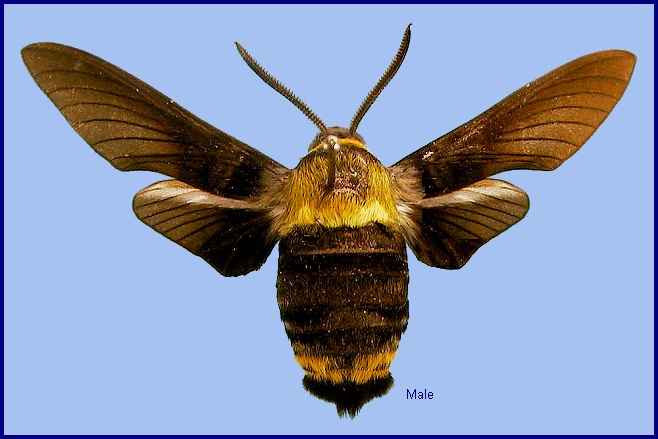

Sataspes xylocoparis Butler, 1875, Proceedings of the Zoological Society of London 1875: . Type locality: Shanghai, China.
Note. Following recent work by Brechlin & Kitching (2009), it has been found that specimens hitherto treated as Sataspes infernalis sensu auctorum belong to two species: Sataspes infernalis sensu stricto (including Sataspes uniformis Butler, 1875 as a junior synonym) and Sataspes xylocoparis Butler, 1875.
Wingspan: 52--58mm (male), 58--70mm (female). A mimic of large bees, particularly species of Xylocopa (carpenter bees).
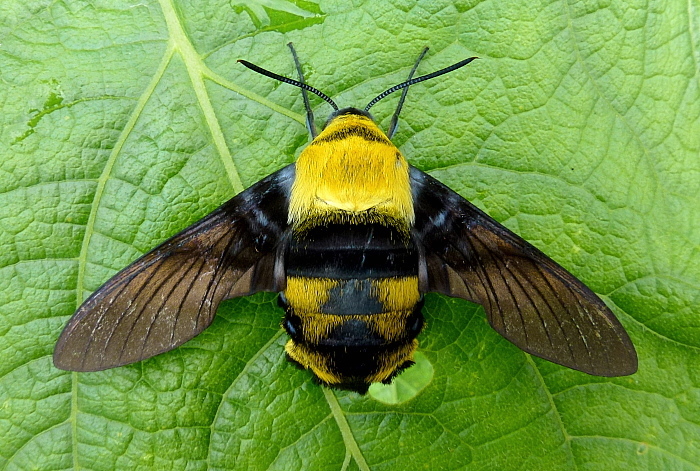
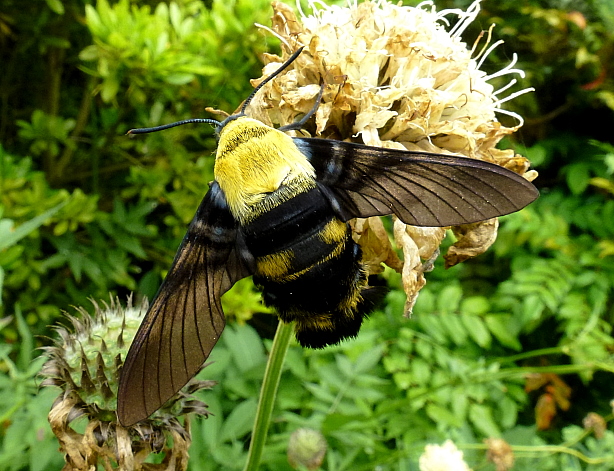
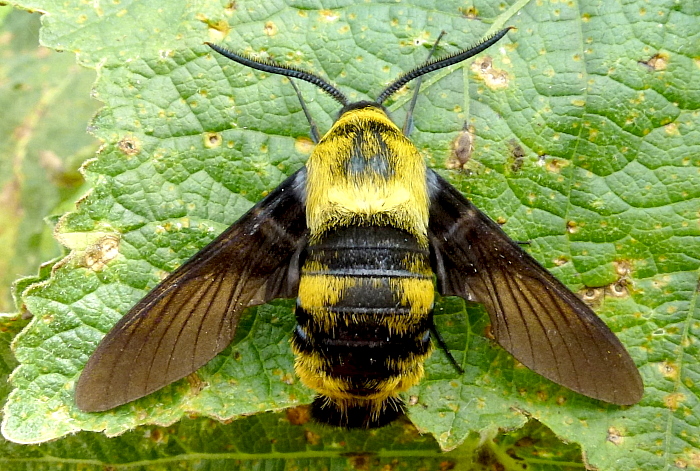
A day-flying moth of shady, dense, mature hillside woodland with fast-flowing streams (Li, 1994). The moth can be seen feeding at flowers up until about 10.00 am (Bell & Scott, 1937).
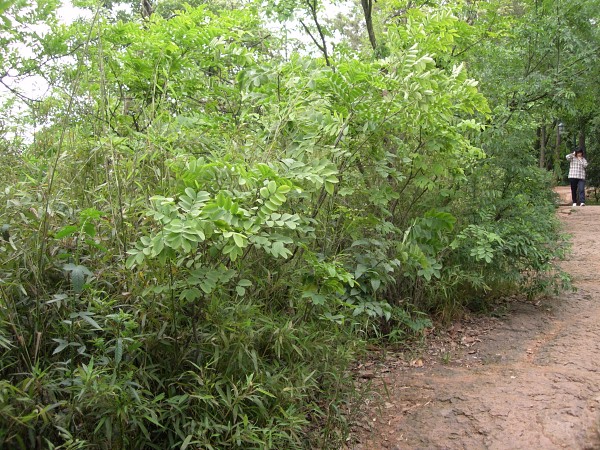
China: iii-iv (Guangdong); iv (Hong Kong); 28.iv (Zhejiang); 12.v (Shaanxi); vi (Jiangxi; Guangdong; Sichuan; Hong Kong; Zhejiang); vii (Shanghai; Zhejiang; Hong Kong); viii (Zhejiang).
OVUM: Pale green, almost spherical (1.5 x 1.5 x 1mm), shiny and smooth. Hatches in about 4 days.
Laid singly on the underside of leaflets towards the tip of overhanging branches. Preference is shown for hostplants that grow together among trees that provide shade (Li, 1994).
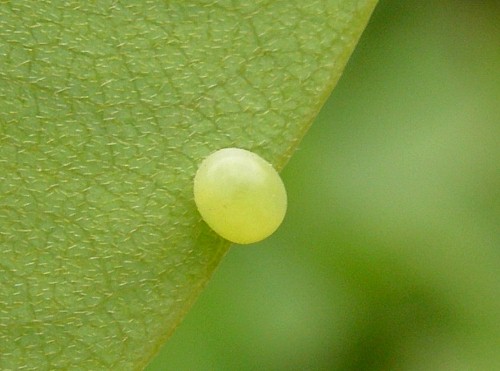
LARVA: Full-fed 40--65mm, width 11mm, head 6 x 6mm, horn 6mm. The early stages have been well documented from Hong Kong by Li (1994).
According to Bell & Scott (1937), in the first instar head round, body cylindrical, horn straight and minutely bifid; head covered with hairs, some simple and some forked. Body with a row of small tubercles encircling each secondary ring, each tubercle with a forked hair. Colour of head yellowish, body pale green, horn black. In the second instar, head triangular, with a short process rising from apex of each lobe; tubercles and hairs as in first instar. Colour of head green, the processes rusty-pink, and a narrow yellow cheek-stripe; body green with faint oblique lateral stripes. There is little change in the third and fourth instars.
In the fifth and final instar, head large, triangular, with rounded vertex and no processes; clypeus between one-third and one-half length of head, apex acute, basal angles tumid; false clypeus and slightly broader than clypeus; ligula kidney-shaped, the lobes broadly rounded at ends. Surface of head shiny, shallowly rugose, the cheek-stripe set into small tubercles. Body tapering gently frontad from segment 8 to 2 and caudad from 8 to 12; 2 is about as broad as the head. Horn short and stout, slightly down-curved, tapering evenly to a sharp point. Surface of body dull; a row of tubercles encircling each secondary ring, very minute except on segments 2 to 4 and on the anterior dorsal portion of remaining segments, where they are slightly larger. Supra- and subspiracular hairs visible, the latter having a short stem dividing into nine branches spread fan-wise horizontally (Bell & Scott, 1937).
In most, head pale green on face, darker green on rest of head, the two colours separated by a broad white cheek-stripe running from vertex to base of antenna; labrum green; ligula white and shiny; two first segments of antenna green, end segment paler green with tip rusty; mandible green, the tip broadly dark reddish-brown; eyes glassy greenish-brown. Body pale glaucous-green, darker on venter. There are six whitish oblique lateral stripes, that on segment 6 sharply defined, those on 7 to 10 diffuse and faint, that on 11 sharply defined, broader, and running across 12 to base of horn. Some larvae have a large pale brown or a reddish-brown patch on 7 and 8 consisting of a diamond-shaped patch on the dorsum flanked by a larger, oval, lateral patch on each side reaching nearly darker red-brown; there may also be similarly coloured diamond-shaped patches on 7 and 10. Horn green. Spiracles yellow with the slit white (Bell & Scott, 1937).
There is also a canary-yellow form with brownish and bluish patches; these patches are variable in size, shape and colour.
The young larva rests in a typical sphinx-like attitude. When molested it exudes a brownish juice copiously from the mouth.
The frass is peculiar, consisting of pieces of leaf held together loosely.
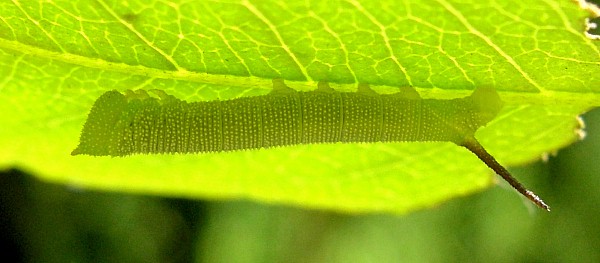
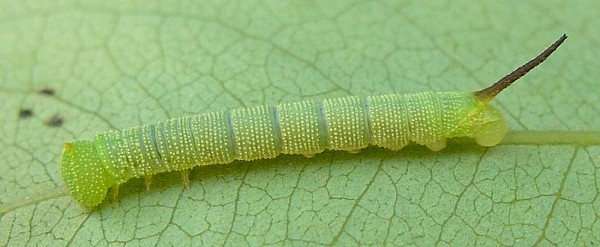
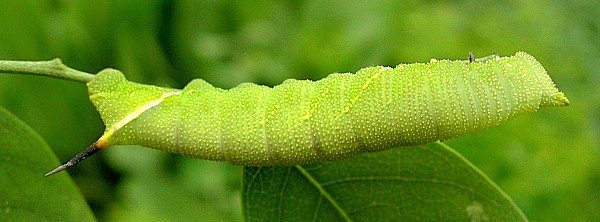
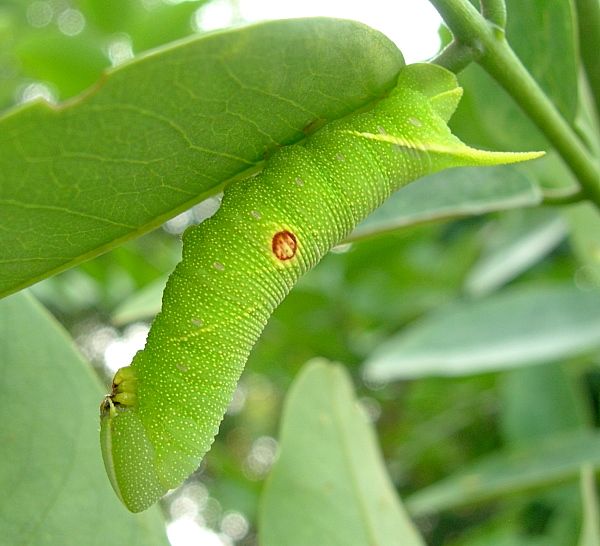
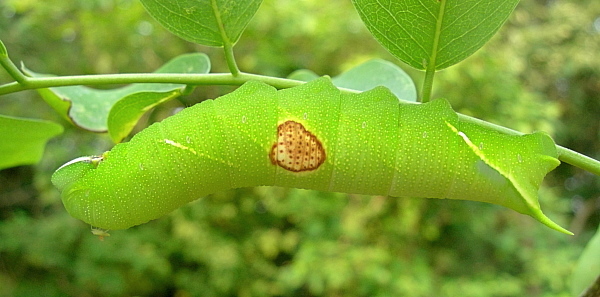
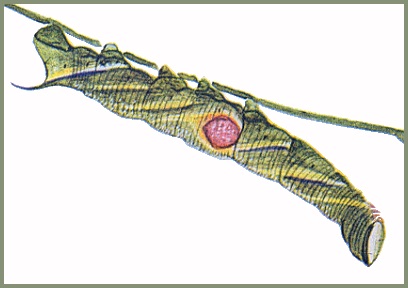
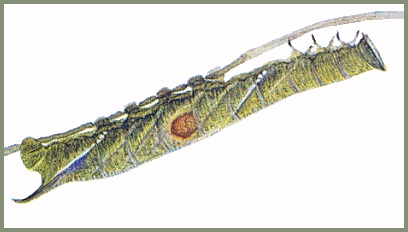
PUPA: 35--42mm, width 11mm. Dark red-brown to nearly black; head, thorax, wing-cases and anal segments nearly black, spiracles red-brown (Bell & Scott, 1937).
Ambulicine in shape; head rounded, body broadest about the middle; frontal ridges similar to those found in Marumba, roughly parallel, close together, the inner face of each ridge nearly vertical, the outer gently sloping. Surface shiny, head, thorax and wing-cases coarsely lined in a manner resembling cracked lacquer; the frontal ridges coarsely pitted and wrinkled; abdomen deeply and coarsely pitted, especially on the anterior half of each segment dorsally and ventrally; sculpturing on segment 4 consisting of a narrow, median, transverse weal on each side of the dorsal line, each weal outlined by a deeply depressed line; ante-spiracular ridges on 9 to 11 consisting of three narrow ridges separated by wide channels. Spiracle of 2 a wide slit with narrow raised edges; those on the remaining segments oval, the surface rising to the central slit with narrow raised edges. Cremaster an equilateral triangle coarsely pitted, ending in a short, stout, shortly bifid shaft (Bell & Scott, 1937).
Pupation takes place in a cell a short depth below the surface, or in a rough cocoon on the surface.
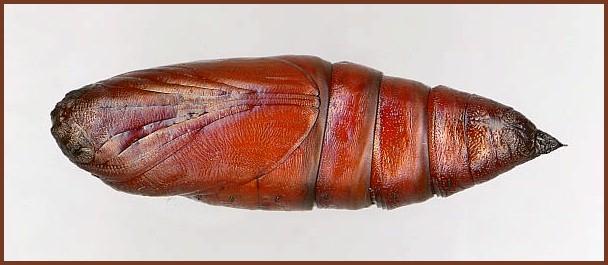
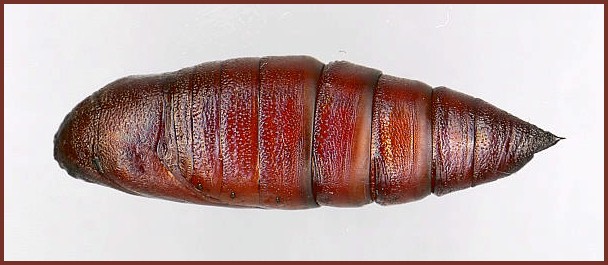
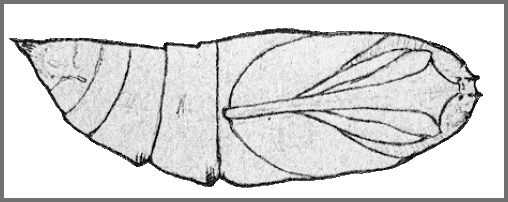
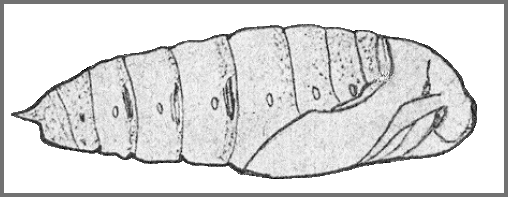
Larval hostplants. The woody climber Dalbergia benthami (Fabaceae) in Hong Kong. Also Lespedeza and Albizia lebbeck farther north. Around West Lake, Hangzhou (Zhejiang, China), the main host is Albizia lebbeck growing in the shade on rocky hillsides, particularly clusters of saplings and small trees (Pittaway, pers. obs. 2012).
China: Shaanxi (Foping County, Qinling); Shanghai (Jiading, 1000'); Zhejiang (Baochu Pagoda, West Lake, Hangzhou; Tianmu Shan, Jiakou, 1700'; Mogan Shan; Xiaofengzhen); Hubei (Jiugongshan National Reserve, Xianning, 400m; Jingxinting); Sichuan (Baoxing; Dadu He; Kangding; Yibin; Xiaolou); Yunnan (Yanmen); Xizang/Tibet; Guizhou (Jiangkou, 520-2100m); Hunan (Zhangjiajie); Jiangxi (Kiujiang); Guangdong (Luofu Shan; Guangzhou); Hong Kong (Tai Po Kau Nature Reserve).
Northeastern India, Nepal, Bhutan, northern Burma/Myanmar, northern Thailand, northern Vietnam and southern/eastern China.
[Sataspes infernalis has been confirmed from SW and NE India, Bangladesh, northern Burma/Myanmar and northern Thailand.]
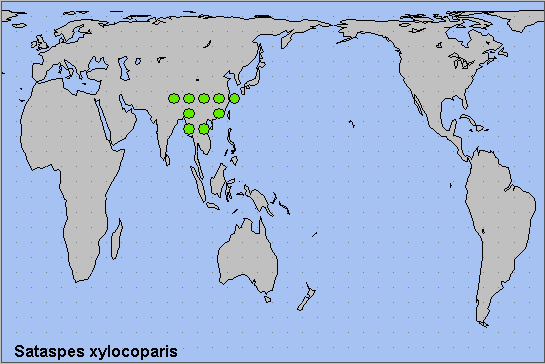
 Return to Sphingidae of the Eastern Palaearctic species list
Return to Sphingidae of the Eastern Palaearctic species list